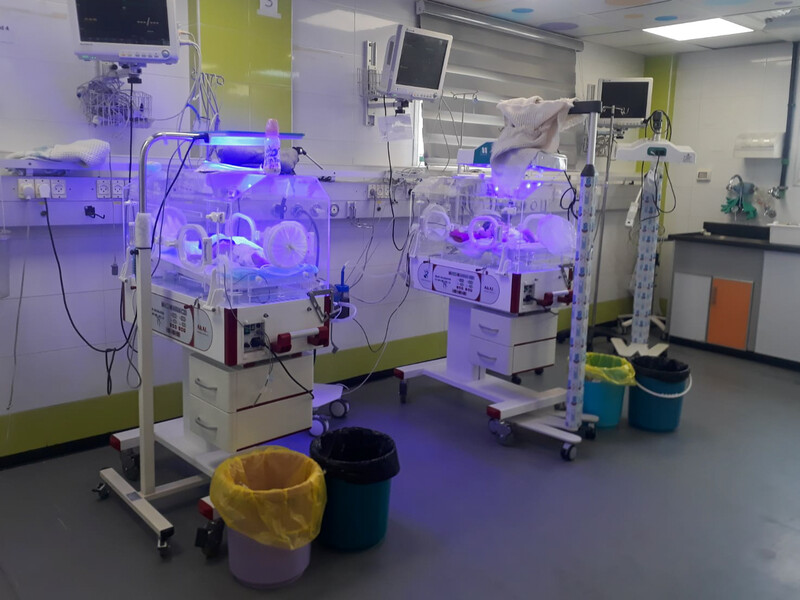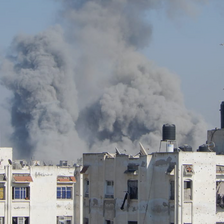The Electronic Intifada 15 April 2025

The nursery at the Nasser Medical Complex in Khan Younis is currently operating beyond capacity.
The Electronic IntifadaMy friend Fidaa Zakaria is a volunteer nurse at the Nasser Medical Complex in Khan Younis. This past March, I made plans to meet her there to get a closer look at what it is like to be a nurse now during this genocide and to observe what she sees and the people she cares for.
On the day we agreed to meet, though, I got a text from Fidaa saying: “The shelling is very intense near us, so I won’t be able to go to work today.”
I live next door to the Nasser Medical Complex, but Fidaa is living a few kilometers away in al-Mawasi near Khan Younis. Her family had set up a tent there when Israeli military operations began near their home in Rafah in May 2024. She later learned that their three-story house in the Tal al-Sultan neighborhood, which overlooks the border between Gaza and Egypt, had been destroyed in Israeli military attacks on the neighborhood that month.
The next day, I texted her again: “Fidaa, our meeting today. Right?” I sent this very early, at six in the morning, because my phone was about to run out of battery.
I was relieved to get her response a few minutes later, as not all meetings in Gaza end with a meeting. “Of course,” she replied.
I tidied up the home and got dressed. Fidaa in her family tent near the sea did the same. She told me that the tent is several meters wide, and she makes her bed before she leaves and then checks to make sure she has everything she needs for the day in her bag: her notebook, a stethoscope and some personal items.
At 7:50 am, Fidaa goes to the street, sometimes with her friend and sometimes alone, to wait for the workers’ bus to Nasser. It is provided by the hospital because it would be too difficult for employees to get there on their own due to the lack of fuel and the mass destruction of vehicles.
When Fidaa arrives at the medical complex, she goes to the building where the maternity unit is located and then heads to the second floor to see which ward she will be assigned to that day.
The maternity unit is divided into three wards: Ward A is for cesarean deliveries; B is for vaginal births; and C is for high-risk cases and follow-ups.
That day, Fidaa was in Ward B.
At the nursery
I arrived at the Nasser Medical Complex to meet her on her break, but she was not there. I waited and looked around, noting elderly women carrying bags containing clothing and other supplies for newborns; some who were not patients asking for supplies for their infants. One woman was asking for a blanket. Several newborns had died this past winter from the cold, and even though it was March, it was still cold some nights.
When Fidaa showed up, she took me to see other areas of the hospital. We went upstairs to the psychological support department, and I met some doctors on the psychological support team.
Then we went to the emergency department, where the beds were full, and everyone was busy. Because of this rushed environment, we did not spend too much time there, and we soon returned to the maternity unit.
Fidaa then showed me the nursery. It was well lit and extremely clean and quiet. Monitors at each crib displayed the children’s vital signs. Some of the babies were bathed in a blue light, which I learned was phototherapy to treat jaundice. Four nurses worked in the nursery caring for the children.
Fidaa explained that the nursery is for babies who were born prematurely, and that its capacity is 20 – and that the nursery is beyond capacity at the moment. There is the constant fear among staff that a lack of fuel and supplies will cause disruption to the nursery and the fragile lives cared for within.
Fidaa returned to her work after her break, while I sat down in the maternity unit to observe and speak to people.
Trauma through generations
I spoke with Narmeen al-Astal, a young mother who was in extreme distress.
She was pregnant when Israeli forces attacked her home in northwest Khan Younis. Narmeen was not at home at the time, but her husband and children were. He was buried under the rubble for days and survived. She had thought he was dead. But two of Narmeen’s children were killed.
Soon afterward, she gave birth via a C-section at Nasser.
I found it hard to fathom becoming a mother after your two children had been killed.
I saw another friend, Hanin, who is a nurse at Nasser. She told me about her patient Malak, who was pregnant when her home in Khan Younis came under attack by Israeli forces.
Malak’s husband, 5-year-old daughter and her fetus were martyred.
Malak had her foot amputated and is still being treated at Nasser, yet Hanin said she expressed the wish that she had been killed with her family so they could all be together.
I walked back home after the hospital visit, the sun still high in the sky, thinking about the mothers at Nasser and the children in the nursery under those blue lights.
Donya Ahmad Abu Sitta is a writer in Gaza.





